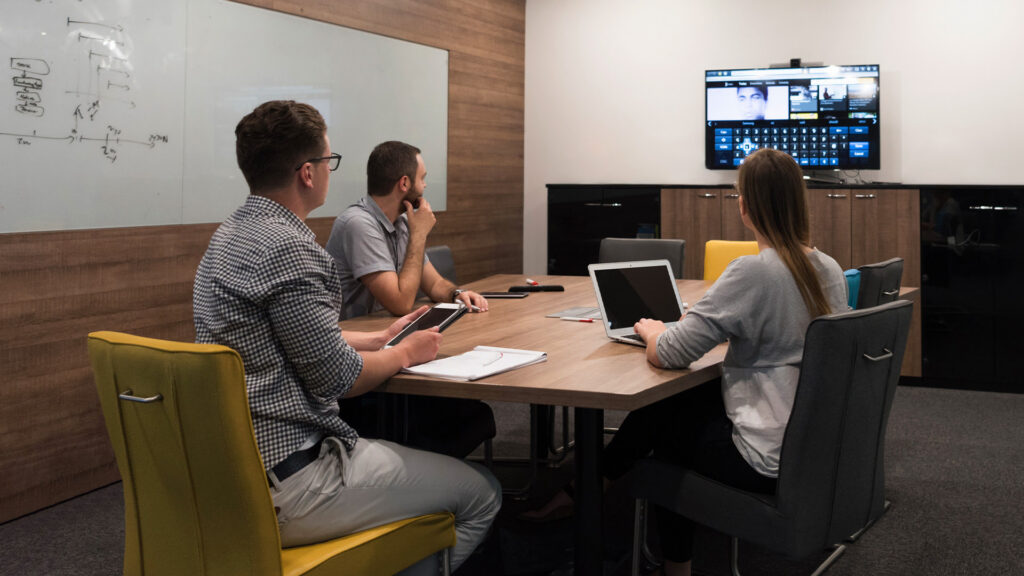I was really disheartened the other day when I heard an IT Director at a major consulting company say that they have video conferencing equipment deployed across the country but they don’t use it much. It wasn’t that I hadn’t heard this before, it takes much more than equipment deployment to make collaboration technology (in this case video conferencing) catch on.
Being an avid user of video conferencing, I am always baffled about why people don’t use their video conference solution. But I realize that it’s a little like John McEnroe asking why everyone doesn’t play tennis. As a seasoned pro, I always want to get to the bottom of what hampers adoption.
So I asked, “Why don’t people use it?”
His reply: “I blame myself for not really understanding the deployment. We wanted to bring 3 locations into a single video call and each location has dual screens. So if I am in Toronto and want to have a call with our New York and San Francisco offices, I want to be able to see New York on one screen and San Francisco on the other screen, but I can’t. I have to look at them both crammed into one screen. So we don’t use the equipment much.”
Unfortunately for this IT director and many like him, that is a lot of money spent on a wasted video conferencing implementation. This is a very real problem and probably a lot more prevalent than you might think.
And he was right. There wasn’t much he could do to get the results he was looking for from his video conferencing deployment (technology design & technology strategy are key for adoption). But that doesn’t mean you have to repeat the mistake he made. You can achieve exactly what the consulting company wanted to with multiple locations on separate screens in the same call.
In fact there is more than one solution but the price difference between them is very different.
First, let’s define the problem.
• Most phone calls are between two people and likewise so are most video calls. The tech speak for a video call between two people is a “point-to-point” call. And if you continue the tech speak analogy, a video call with more than two people is a multi-point call.
• Most of the traditional video conferencing vendors – Polycom, Cisco, LifeSize, Radvision, Sony, etc., use a communication protocol called H.323 and when a multi-point call is made using H.323, what happens is that the video streams from each location are “combined” and sent to the other locations as a single stream.
• So in the example above, the Toronto location would get a single video stream sent to it which has the people from New York and San Francisco “combined” into a single video stream. This single video stream can only be viewed on a single screen – it can’t be split up over two screens. This practice causes the video images of the remote locations to shrink on the display, dramatically diminishing the value of the video images.
In other words, the screen real estate which the people in the other locations occupy on the screens is drastically reduced. Screen real estate was critical to the Consulting Company and real estate is critical to a good video conferencing experience – see these blogs for more…
- • What the Movies Can Teach Us About Real Time Collaboration
- • Screen Real Estate – a Critical Factor in Making Video Calls As Good As “Being There”
- • The 5 Biggest Mistakes Made in Determining Screen Real Estate in a Video Conferencing Room
So what can you do to achieve video conference adoption?
Option 1: Have More than One Codec
With all the traditional video conferencing vendors, if you set up each location with 2 codecs and 2 cameras, you then have each codec in the office call one of the other 2 offices. Then all the participants will be full screen on one of the 2 screens in the room.
Problems with Option 1
Twice as expensive; clumsy call operation; this solution will not scale. Besides the obvious cost differential of adding a second codec and camera at each location, trying to integrate and operate two separate calls simultaneously is very difficult and most end users will never pull it off. The scaling problem comes into play if you try to use this solution when adding in a 4th or 5th location into the call.
Option 2: Go Telepresence
This is similar to Option 1 in that there are either multiple cameras or codecs deployed in the Telepresence rooms but the images are stitched together and combined and sent to other locations as a single image to be displayed on a set up that is exactly the same (physical mirror images of each other) at the other locations.
Problems with Option 2
There are no problems with this type of deployment, however they are very expensive. It takes a lot of technology, network and integration to elegantly pull off the high end Telepresence solutions. But they are elegant and they work beautifully. These rooms also tend to become dedicated “Video Conferencing Rooms” and not multi-purpose. This is not good or bad, just a fact.
Option 3: Use a Different Video Technology
If you move out of the H.323 world and move to a newer video technology, you can deploy room systems that will allow you to use a single processor (codec equivalent) to put full screen images on both of the screens in the Toronto – New York – San Francisco example. These commercial video solutions will allow for support for two screens with active presence or video on each screen. The video architectures will let you move beyond 2 screens and go up to 20 screens – Hollywood Squares Plus!!!
Note: This solution would not only have provided the Consulting Company with exactly what they were looking for but it would have cost them less than the video solution they deployed.
Problems with Option 3
There are no problems with this approach except that if you have an existing video deployment like the Consulting Company mentioned above, you have to basically replace the core of the old solution with the new (except for the screens), plus, if you do go beyond a 2 screen system you will need to invest in additional decoders for each of the extra screens beyond the initial two.
There are very good solutions out there to make your video collaboration experiences as good, or better, than actually being there! Doing it right will increase the velocity of collaboration in your organization.
Stay tuned to the blog for some of the upcoming topics including best options for sharing content and video in a collaborative call.








